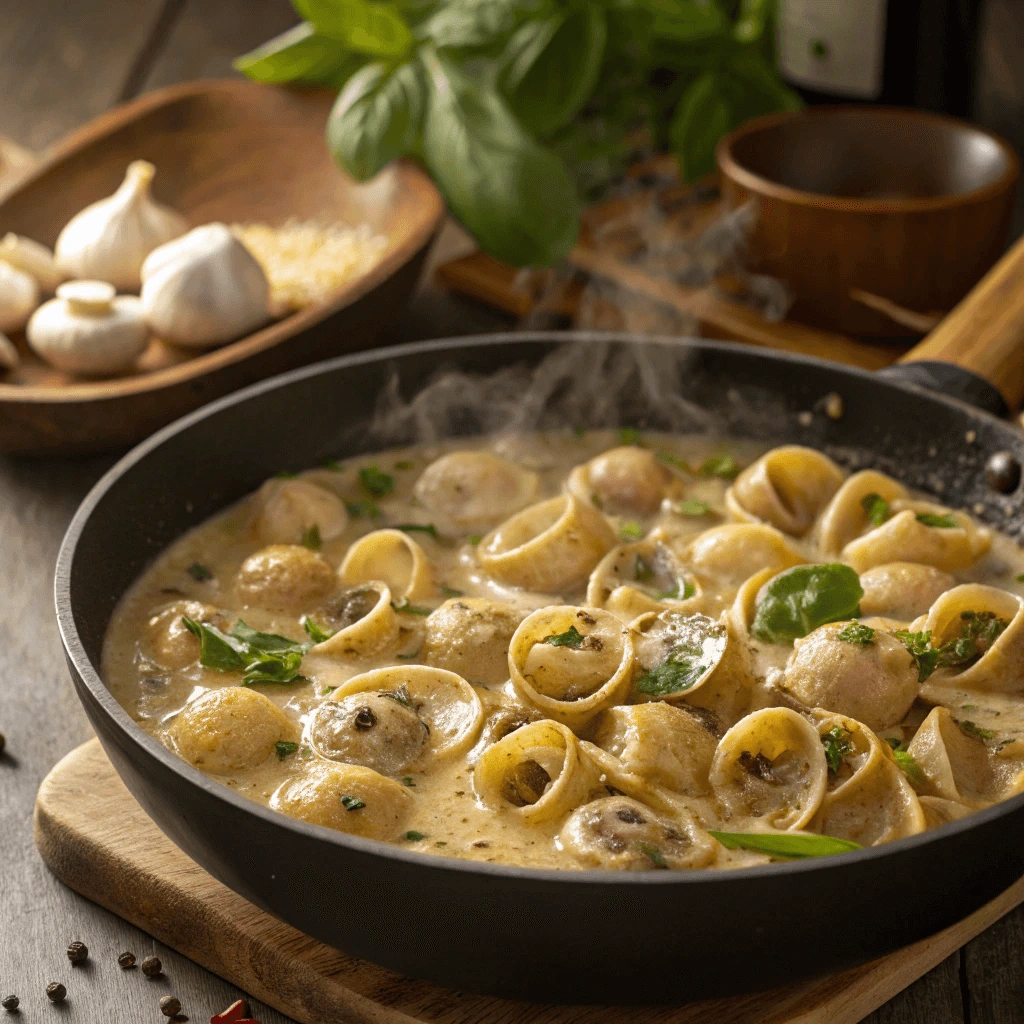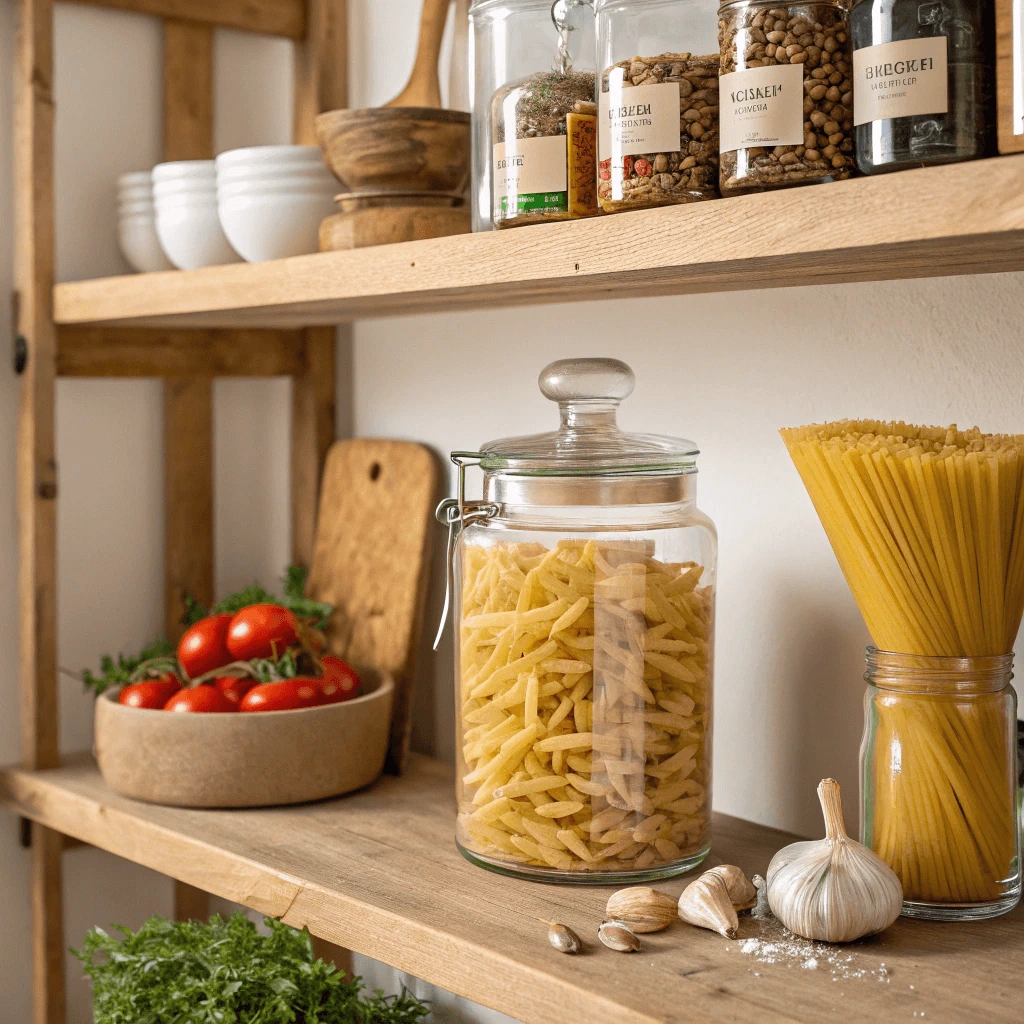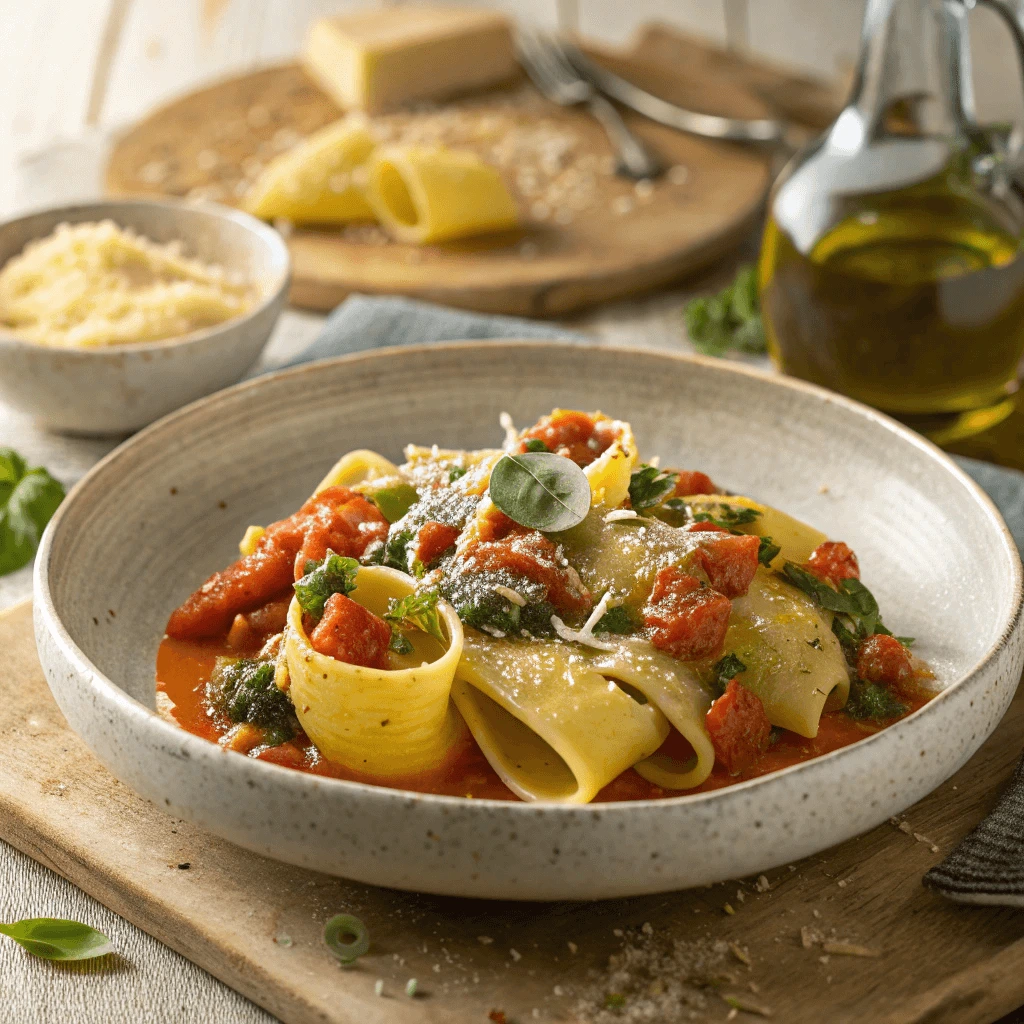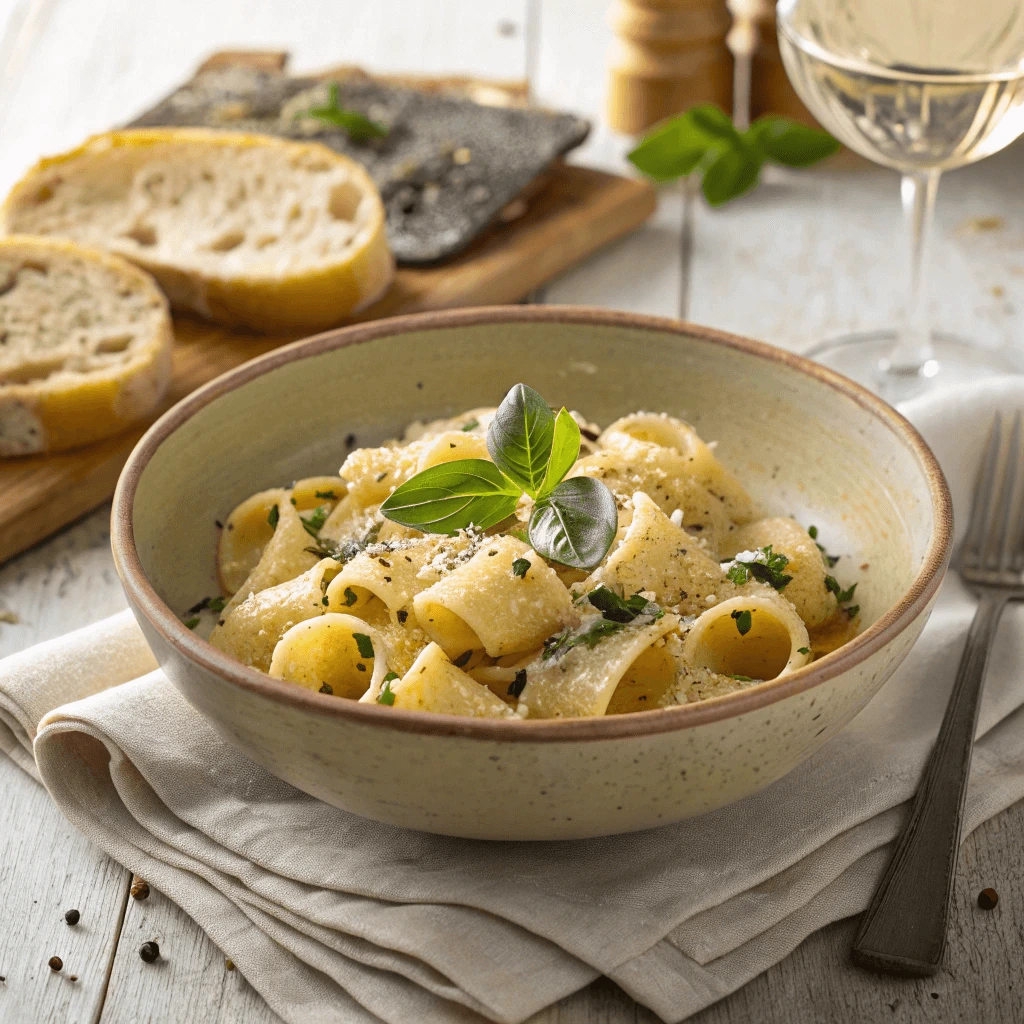If you’re wondering why lumache pasta deserves a spot in your pantry, the answer lies in its unique shape and incredible versatility. Lumache, with its snail-shell design, captures sauces perfectly and adds a delightful texture to any dish. Whether you’re preparing a quick weeknight dinner or an impressive meal for guests, knowing how to cook lumache pasta will elevate your pasta game and bring authentic Italian flavors to your kitchen.
The Meaning Behind the Name “Lumache”

The Meaning Behind the Name “Lumache”
A Name Inspired by Nature
The word “lumache” comes directly from the Italian word for snails. This pasta gets its name because its unique, curled shell shape closely resembles a snail’s shell. Italians named it after nature, not just for the shape, but also for how it functions in a dish—just like a snail’s shell protects its body, Lumache pasta “holds” sauces inside its curves, delivering flavor in every bite.
Why Shape Matters in Italian Cooking
In Italian cuisine, pasta shape is never random. The design of Lumache isn’t just for looks—it plays a vital role in how the pasta interacts with the sauce. The hollow, curved structure traps chunky sauces, cheese, or even bits of vegetables and meat. This practical function makes Lumache ideal for thick sauces and hearty meals.
The Cultural Significance of Lumache Pasta
Beyond the name and structure, Lumache carries cultural value. Many traditional Italian households use Lumache in comfort foods or regional specialties. In southern Italy, for instance, it’s commonly served with a rich tomato-based sauce or a creamy cheese blend. The shape evokes a sense of home and tradition—two central themes in Italian cooking.
By understanding the meaning behind the name, you also begin to see why Lumache pasta deserves a spot in your pantry. It’s more than a pretty shape—it’s a thoughtful design rooted in tradition, purpose, and flavor.
A Closer Look at the Shape and Texture
The Distinctive Curl of Lumache Pasta
Lumache pasta stands out with its unique shape, which closely resembles a snail shell. The pasta curls into a half-moon or shell-like form, often with one open end and a gently tapered side. This design isn’t just visually appealing—it serves a purpose. The curled structure traps sauces, making every bite more flavorful and satisfying.
Hollow Center Means More Flavor in Every Bite
The hollow interior of Lumache acts as a flavor pocket. As you stir it into a sauce, ingredients like minced garlic, chopped vegetables, or melted cheese slip inside the pasta’s curves. This helps create rich, well-balanced forkfuls. Unlike flatter pastas that let sauces slide off, Lumache embraces whatever you toss it with—making it ideal for thicker, textured sauces.
A Textural Experience That’s Hard to Beat
Made from high-quality durum wheat semolina, Lumache pasta offers a firm, chewy bite when cooked al dente. Its ridged exterior (if ribbed) helps sauce adhere to the surface, while the dense body adds substance to the dish. The contrast between its soft center and slightly firmer edge gives the pasta a satisfying mouthfeel. This texture holds up well in baked dishes and reheats beautifully, making it a pantry staple you can depend on.
How Lumache Differs from Other Pasta Shapes
When choosing pasta, the shape you use can greatly affect the texture, sauce absorption, and overall dining experience. Lumache pasta stands out among other varieties for several reasons. Let’s explore how it compares to common pasta shapes like penne, rigatoni, and conchiglie (shells).
Unique Curved Shell-Like Shape
Lumache, which means “snail” in Italian, has a curved, ridged, and semi-enclosed form that sets it apart. While conchiglie also resembles a shell, lumache is slightly twisted and has one end closed, which helps trap sauces more effectively. This shape makes each bite rich and flavorful.
Superior Sauce Retention
Compared to penne or rigatoni, which are tubular and open on both ends, lumache holds thicker or chunky sauces better. The pasta’s internal pocket captures ingredients like mushrooms, diced vegetables, or creamy cheese sauces, delivering a fuller taste with every bite. You don’t just coat lumache in sauce—you fill it.
Soft Yet Satisfying Texture
Lumache cooks to a perfect al dente consistency that combines a chewy bite with a tender outer texture. Its ridges grip sauces better than smooth-surfaced pastas like ziti. Unlike rigatoni, which can feel a bit heavy or dense, lumache feels light but still hearty.
Versatility with Various Cuisines
Although traditional to Italian kitchens, lumache works well in global fusion recipes, including meatless or dairy-free versions. Whether paired with a creamy Parmesan sauce or a zesty tomato basil blend, this pasta adapts beautifully. Other shapes like fusilli or farfalle might look playful, but they don’t offer the same balance of shape, texture, and sauce harmony.
Pantry Staple Potential: Why Lumache Pasta Belongs in Your Kitchen

Long Shelf Life and Easy Storage
Lumache pasta is a smart pantry staple, not only because of its versatility but also due to how well it stores. Its long shelf life and easy storage requirements make it a convenient choice for busy households or anyone who enjoys cooking without frequent grocery runs.
Why Lumache Pasta Lasts So Long
Thanks to its dried form and high-quality durum wheat content, lumache pasta can last for months—often up to two years—when stored properly. Unlike fresh pasta, which spoils quickly, dried lumache doesn’t require refrigeration. You can confidently buy it in bulk without worrying about waste.
Proper Storage Techniques for Maximum Freshness
To maintain quality, store lumache pasta in a cool, dry place away from direct sunlight. Use airtight containers or sealed pantry jars to protect it from moisture and pantry pests. This not only extends the shelf life but also helps retain its texture and flavor.
Avoid storing it near the stove or dishwasher, where steam and heat can reduce its shelf stability. A dedicated pantry shelf or kitchen cabinet works best. Keeping your pasta in its original packaging inside a resealable bag is also an effective option.
Why It’s Perfect for Quick Meals
Because lumache pasta stores so well, it’s always ready when you need a quick meal. Whether you’re whipping up a simple tomato sauce or experimenting with veggies and cheese, having lumache on hand saves time and eliminates the stress of last-minute dinner planning.
Perfect for Quick Weeknight Dinners
Lumache pasta is the ultimate solution for busy weeknights. Its unique shape, quick cook time, and adaptability to a wide range of sauces make it a go-to option when you need to get dinner on the table fast—without sacrificing flavor or quality.
Quick Cooking Time Saves You Stress
You can cook lumache pasta to al dente in just 8–12 minutes, depending on the brand. This makes it ideal for those hectic evenings when time is short and energy is low. Simply boil salted water, toss in the lumache, and let it cook while you prepare your sauce or toppings. The pasta holds its shape beautifully and doesn’t get mushy, even when tossed into warm sauces.
Pairs Easily with Simple Ingredients
What makes lumache pasta especially useful on weeknights is its compatibility with pantry and fridge staples. Toss it with sautéed garlic and olive oil for a classic aglio e olio, or stir in some tomato paste, herbs, and a bit of cheese for a quick marinara. If you have spinach, mushrooms, or leftover grilled chicken, add them for extra texture and nutrition. No need to overthink your meal—lumache works with whatever you have on hand.
Makes Family Meals More Enjoyable
Lumache’s curved, shell-like shape captures sauces and bits of ingredients in every bite, making meals more satisfying and enjoyable for the whole family. Even picky eaters tend to love its fun shape and soft yet chewy texture. You can prepare a delicious, comforting meal that everyone will eat—without complaints or complex steps.
Whether you’re cooking for one or feeding a full table, lumache pasta transforms last-minute plans into stress-free, delicious dinners.
Great Base for Multiple Flavors
Lumache pasta’s versatility makes it an excellent base to carry and enhance a wide variety of flavors. Its shape and texture allow it to pair well with simple sauces or complex, layered dishes, giving you endless culinary possibilities.
Shape That Holds Sauce Beautifully
The curved, snail-shell shape of lumache naturally traps sauces inside its hollow, allowing each bite to deliver maximum flavor. Whether you use a creamy cheese sauce, a tangy tomato blend, or a hearty vegetable ragù, the pasta holds onto the sauce rather than letting it slide off. This characteristic elevates the overall taste experience and ensures that every forkful bursts with flavor.
Adapts to Different Cooking Styles
Lumache pasta works well in many cooking methods, from traditional boiling and saucing to baking in casseroles or tossing in cold pasta salads. You can layer it with fresh herbs and roasted vegetables for a light summer dish or simmer it in a rich broth with poultry or mushrooms for a comforting winter meal. This adaptability helps you create diverse meals while using the same reliable pasta base.
Complements a Variety of Ingredients
Whether you prefer vegetarian dishes, cheese-based sauces, or poultry and seafood accompaniments, lumache pasta complements them all. It absorbs the subtle nuances of fresh herbs like basil and oregano while providing a chewy texture that balances creamy or chunky additions. Its neutral yet satisfying flavor profile allows you to experiment freely with spices, oils, and other ingredients without overwhelming your palate.
Using lumache as a base, you can confidently explore different flavor combinations and cooking techniques, making it a staple for both everyday meals and special occasions.
How to Cook Lumache Pasta for Best Results

Use Plenty of Salted Boiling Water
Using enough salted boiling water is a fundamental step to perfectly cook lumache pasta. It ensures the pasta cooks evenly, develops great flavor, and avoids sticking together.
Why Use Plenty of Water?
When you cook pasta, you want it to move freely in the pot. Using a large amount of boiling water helps the lumache pasta stay separate rather than clumping. Crowding pasta in too little water causes uneven cooking and gummy texture. For every 100 grams of pasta, use at least 1 liter (about 4 cups) of water to give the pasta enough space.
The Importance of Salt in Boiling Water
Adding salt to the boiling water enhances the pasta’s flavor from the inside out. Italians often say the pasta water should taste “like the sea” because it needs to be salty enough to season the pasta properly. A general rule is to add about 1 to 1.5 tablespoons of coarse salt per 4-5 liters of water. Avoid adding salt before the water boils, as this can slow down the boiling process.
How to Salt the Water Correctly
Start by bringing the water to a rolling boil. Then add the salt and stir it to dissolve fully before adding your lumache pasta. This step ensures the salt evenly seasons the water, which transfers flavor to the pasta while it cooks. Don’t skimp on the salt—you’ll notice the difference in taste if you use less.
Tips for Boiling Lumache Pasta
Cook the lumache until it reaches al dente — tender but still firm to the bite.
Stir the pasta occasionally during cooking to prevent sticking.
Keep the water boiling steadily, and avoid covering the pot once the pasta is in.
Reserve Pasta Water for the Sauce
Reserving pasta water might seem like a small step, but it plays a crucial role in creating the perfect sauce for your lumache pasta. The starchy water enhances the sauce’s texture and helps it cling beautifully to each pasta piece.
Why Save Pasta Water?
When pasta cooks, it releases starch into the boiling water, making it cloudy and slightly thickened. This starch-rich water acts as a natural thickener and emulsifier for your sauce. Adding reserved pasta water to your sauce improves its consistency without thinning it out. It also helps bind the sauce ingredients to the pasta, resulting in a more flavorful, cohesive dish.
How Much Pasta Water Should You Reserve?
Before draining your lumache pasta, scoop out about one cup of the pasta cooking water. Use a heatproof measuring cup or ladle to catch the water easily. You don’t need to reserve too much — just enough to adjust the sauce’s thickness and texture as needed during the finishing steps.
When to Add Pasta Water to the Sauce
After draining the pasta, transfer it directly to the pan with your sauce. Slowly pour in small amounts of the reserved pasta water while tossing the pasta and sauce together over medium heat. This technique allows the starch to emulsify with fats and liquids in the sauce, creating a silky, smooth finish. Keep adding pasta water bit by bit until you reach the perfect consistency.
Tips for Using Pasta Water Effectively
- Use freshly reserved pasta water — it works best while still warm.
- Avoid adding too much at once to prevent the sauce from becoming too watery.
- If your sauce thickens too much as it cools, a splash of reserved pasta water can loosen it up.
- Remember, pasta water also carries salt from the cooking process, so adjust seasoning carefully.
Always Finish in the Sauce, Not Separately
Finishing lumache pasta in the sauce is key to making a delicious dish. Instead of just pouring sauce over cooked pasta, toss the pasta directly in the sauce. This lets the pasta soak up the flavors and makes every bite rich and well-coated.
Why It Matters
When you combine pasta and sauce in the pan, the sauce clings better to the pasta’s ridges and curves. The starch released from the pasta also helps thicken the sauce, creating a creamy texture that sticks perfectly to each piece of lumache.
How to Do It
After draining the pasta, add it to the simmering sauce. Toss gently over medium heat to mix well. If the sauce feels too thick, add a little reserved pasta water to loosen it. This water helps the sauce and pasta blend smoothly.
Benefits
- Full Flavor: The pasta absorbs the sauce’s taste deeply.
- Perfect Texture: The sauce thickens and coats the pasta evenly.
- Professional Touch: Your dish looks glossy and appetizing.
Always finishing your lumache pasta in the sauce guarantees a tasty, authentic Italian meal every time.
Delicious Recipes You Can Make with Lumache Pasta
Creamy Parmesan and Garlic Lumache
This creamy Parmesan and garlic sauce perfectly complements lumache pasta’s unique shape, allowing the sauce to cling beautifully to each shell.
Preparing the Sauce
Start by melting butter in a pan over medium heat. Add minced garlic and sauté until fragrant, about 1-2 minutes. Pour in heavy cream and stir gently, letting it simmer to thicken slightly.
Adding Cheese and Seasoning
Gradually stir in freshly grated Parmesan cheese until the sauce becomes smooth and creamy. Season with salt, pepper, and a pinch of nutmeg to enhance the flavor.
Combining Pasta and Sauce
Drain the cooked lumache, reserving some pasta water. Toss the pasta in the sauce over low heat, adding a bit of reserved water if the sauce needs loosening. This helps the sauce coat each piece perfectly.
Tomato Basil Lumache with Olive Oil
This classic tomato basil sauce brings a fresh, vibrant flavor that pairs beautifully with lumache pasta. The olive oil enhances the sauce’s richness while keeping it light and healthy.
Preparing the Tomato Basil Sauce
Begin by heating extra virgin olive oil in a large skillet over medium heat. Add finely chopped garlic and sauté until golden and aromatic. Next, add crushed ripe tomatoes or high-quality canned tomatoes. Let the sauce simmer gently, stirring occasionally to deepen the flavors.
Infusing Fresh Basil
Tear fresh basil leaves and stir them into the sauce just before finishing the simmer. The basil releases its sweet, peppery aroma, complementing the acidity of the tomatoes perfectly.
Combining Lumache with the Sauce
Cook the lumache pasta until al dente, then drain it while reserving a small cup of the pasta water. Toss the pasta into the tomato basil sauce and add a splash of the reserved pasta water to help the sauce cling better to each shell. Stir gently to coat all the lumache evenly.
Finishing Touches
Drizzle a little more olive oil over the plated pasta for added silkiness and garnish with fresh basil leaves or a sprinkle of grated Parmesan cheese if desired.
Savory Mushroom and Spinach Lumache
Lumache pasta works beautifully with a savory mushroom and spinach sauce. This combo offers rich, earthy flavors balanced by fresh greens, perfect for a vegetarian meal.
Sauté Mushrooms for Flavor
Heat olive oil in a pan over medium heat. Add sliced mushrooms and cook until they turn golden brown and release their juices. Stir often to develop a deep, savory flavor.
Add Spinach and Garlic
Next, add fresh spinach leaves to the pan and cook until they wilt. Toss in minced garlic for aroma and a pinch of red pepper flakes for a gentle spice.
Make a Creamy Sauce
Pour in a little vegetable broth or water to deglaze the pan, scraping up any browned bits. Stir in cream or a dairy-free alternative and cook until the sauce thickens slightly.
Combine Lumache Pasta and Sauce
Cook lumache pasta until al dente and drain, reserving some pasta water. Toss the pasta into the sauce, adding pasta water as needed to help the sauce cling to the shells.
Garnish and Serve
Finish with fresh chopped herbs like parsley or basil and sprinkle grated Parmesan or vegan cheese for extra flavor.
Where to Find and Buy High-Quality Lumache Pasta
Top Grocery Stores and Brands to Try
Finding quality lumache pasta starts with knowing where to shop and which brands to trust.
Grocery Stores to Check Out
Major grocery stores like Whole Foods, Trader Joe’s, and Wegmans often carry lumache pasta. Specialty Italian markets also offer a great selection, including artisanal options for authentic flavor.
Reliable Brands for Lumache Pasta
Popular brands such as De Cecco and Barilla produce durable, high-quality lumache made from durum wheat semolina. These brands deliver consistent texture and taste, making them excellent choices.
Online and Local Options
You can also buy lumache pasta online from sites like Amazon and Eataly, where you’ll find a variety of brands. Local artisan pasta makers sometimes offer unique, hand-crafted lumache, adding extra freshness and flavor.
Shopping Tips for Quality Pasta
Choosing the right lumache pasta can elevate your cooking and make a noticeable difference in taste and texture. Here are some essential tips to help you select quality pasta every time.
Check the Ingredients List
Always look for pasta made from 100% durum wheat semolina. Durum wheat provides a firm texture and holds sauce well. Avoid pastas with added fillers or artificial ingredients to ensure an authentic taste.
Opt for Bronze-Cut Pasta
Bronze-cut pasta has a rougher surface compared to machine-cut pasta. This texture helps sauces cling better, enhancing flavor in every bite. Many artisanal pasta brands use bronze dies during production, so keep an eye out for this feature.
Consider Fresh vs. Dried Pasta
Fresh pasta offers a tender texture but has a shorter shelf life. Dried pasta lasts longer and typically has a more robust bite when cooked properly. Choose according to your recipe needs and storage preferences.
Check the Packaging Date
Look for the freshest pasta by checking the packaging or production date. Fresher pasta will deliver better texture and flavor. Avoid expired or very old pasta, as it may become brittle or stale.
Buy from Reputable Stores or Brands
Purchase your pasta from trusted grocery stores or specialty shops. Brands like De Cecco, Garofalo, and Rustichella d’Abruzzo consistently produce high-quality lumache pasta that home cooks and chefs trust.
Online Stores for Pantry Replenishment
When it comes to stocking up on lumache pasta and other Italian pantry essentials, online shopping offers unmatched convenience. Below, we explore the best online stores where you can find high-quality pasta and related ingredients.
Trusted Online Retailers for Italian Pasta
Several online retailers specialize in authentic Italian ingredients, including lumache pasta. Websites like Amazon, Eataly, and Italian Harvest provide a wide range of pasta brands and types. These platforms offer detailed product descriptions and customer reviews, helping you make informed choices from the comfort of your home.
Specialty Italian Food Shops Online
Look for online specialty shops that focus exclusively on Italian products. Stores such as Gustiamo and Formaggio Kitchen curate high-quality lumache pasta sourced directly from Italy. These shops often provide insights about the pasta’s origin, production process, and ideal cooking methods.
Subscription Boxes for Pasta Lovers
If you want to replenish your pantry regularly, consider subscribing to a pasta or Italian food subscription box. Services like Pasta Evangelists deliver fresh and dried lumache pasta right to your doorstep, paired with authentic sauces and recipe cards. This option allows you to discover new brands and flavors while keeping your pantry stocked effortlessly.
Benefits of Online Shopping for Pasta
Shopping online saves time and offers access to a wider selection than many local grocery stores. You can compare prices, read reviews, and often find exclusive products. Plus, most online stores ship directly to your door, ensuring you always have lumache pasta ready for your next delicious meal.
Conclusion
Lumache pasta deserves a spot in your pantry because of its unique shape, versatility, and ability to elevate any meal. Its snail-shell design holds sauces beautifully, making every bite flavorful. Lumache pairs well with a variety of sauces, from creamy to tomato-based, and works perfectly with vegetables and poultry. It also stores well, ensuring you have a quick and delicious option on hand for weeknight dinners. Adding lumache pasta to your pantry means bringing a taste of authentic Italian cuisine to your table anytime.
